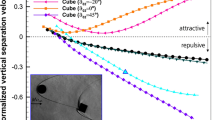Abstract
A novel panel-free approach based on the method of fundamental solutions (MFS) is proposed to solve the potential flow for predicting ship motion responses in the frequency domain according to strip theory. Compared with the conventional boundary element method (BEM), MFS is a desingularized, panel-free and integration-free approach. As a result, it is mathematically simple and easy for programming. The velocity potential is described by radial basis function (RBF) approximations and any degree of continuity of the velocity potential gradient can be obtained. Desingularization is achieved through collating singularities on a pseudo boundary outside the real fluid domain. Practical implementation and numerical characteristics of the MFS for solving the potential flow problem concerning ship hydrodynamics are elaborated through the computation of a 2D rectangular section. Then, the current method is further integrated with frequency domain strip theory to predict the heave and pitch responses of a containership and a very large crude carrier (VLCC) in regular head waves. The results of both ships agree well with the 3D frequency domain panel method and experimental data. Thus, the correctness and usefulness of the proposed approach are proved. We hope that this paper will serve as a motivation for other researchers to apply the MFS to various challenging problems in the field of ship hydrodynamics.
Similar content being viewed by others
References
Mctaggart K. An improved strip theory program for ship motions and sea loads in waves [R]. Canada: National Defence of Canada, 1997: 1–10.
Salvesen N, Tuck E O, Faltinsen O M. Ship motions and sea loads [J]. Transactions of the Society of Naval Architects and Marine Engineers, 1970, 78(6): 250–287.
Golberg M A. The method of fundamental solutions for Poisson’s equation [J]. Engineering Analysis with Boundary Elements, 1995, 16: 205–213.
Fairweather G, Karageorghis A. The method of fundamental solutions for elliptic boundary value problems [J]. Advances in Computational Mathematics, 1998, 9: 69–95.
Chen C S, Karageorghis A. The method of fundamental solutions — A meshless method [M]. USA: Dynamic Publishers, 2008.
Peter M, Youssef F R. Convergence and stability of the method of meshless fundamental solutions using an array of randomly distributed sources [J]. Engineering Analysis with Boundary Elements, 2004, 28: 143–153.
Li X. On convergence of the method of fundamental solutions for solving the Dirichlet problems of Poisson’s equation [J]. Advances in Computational Mathematics, 2005, 23: 265–277.
Karageorghis A, Fairweather G. The method of fundamental solutions for the solution of nonlinear plane potential problems [J]. IMA Journal of Numerical Analysis, 1989, 9: 231–242.
Karageorghis A. The method of fundamental solutions for the solution of steady state free boundary problems [J]. Journal of Computational Physics, 1992, 98: 119–128.
Sarler B. Solution of potential flow problems by the modified method of fundamental solutions: formulations with the single layer and the double layer fundamental solutions [J]. Engineering Analysis with Boundary Elements, 2009, 33(12): 1374–1382.
Wang H, Qin Q H Some problems with the method of fundamental solution using radial basis functions [J]. Acta Mechanica Solida Sinica, 2007, 20(1): 21–29.
Larsson L, Stern F, Visonneau M. A workshop on numerical ship hydrodynamics [C]//Proceedings of Gothenburg 2010. Gothenburg, Sweden: Chalmers University of Technology, 2010: 107–136.
Author information
Authors and Affiliations
Corresponding author
Additional information
Foundation item: the Fund of the Minister of Education and Minister of Finance of China (No. ZXZY019)
Rights and permissions
About this article
Cite this article
Feng, Py., Ma, N. & Gu, Xc. Application of method of fundamental solutions in solving potential flow problems for ship motion prediction. J. Shanghai Jiaotong Univ. (Sci.) 18, 153–158 (2013). https://doi.org/10.1007/s12204-013-1378-1
Received:
Published:
Issue Date:
DOI: https://doi.org/10.1007/s12204-013-1378-1




